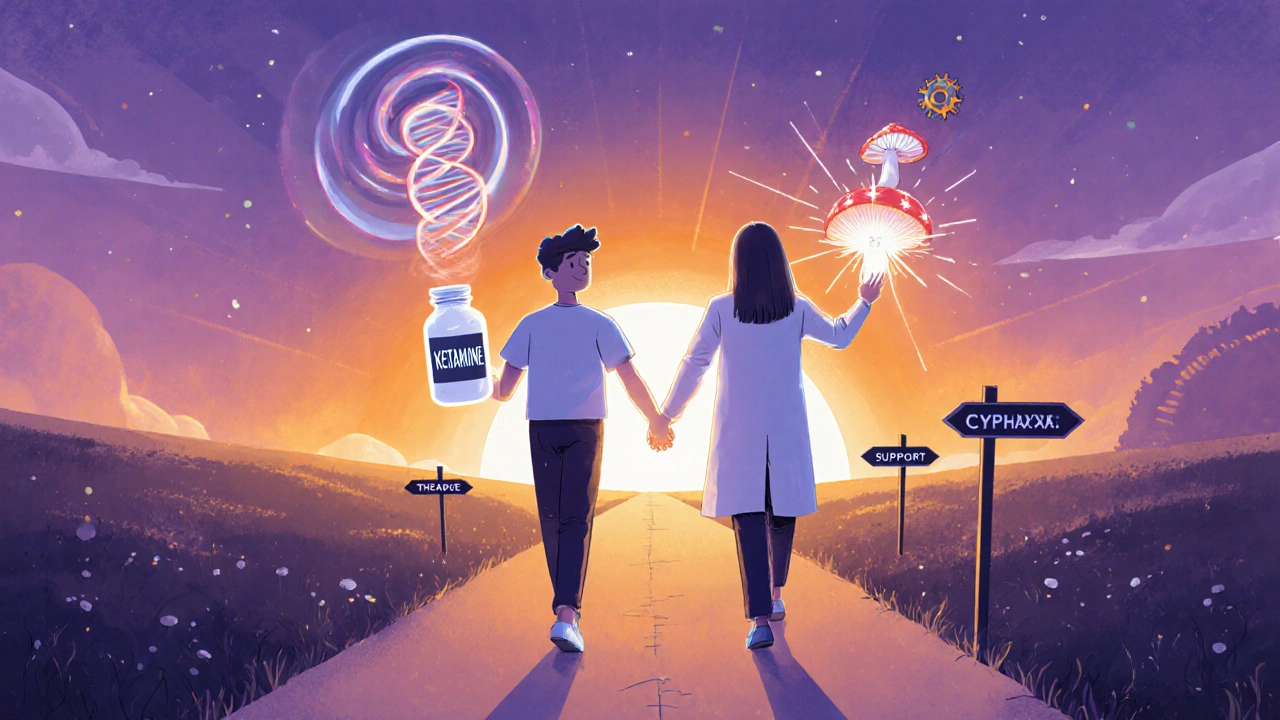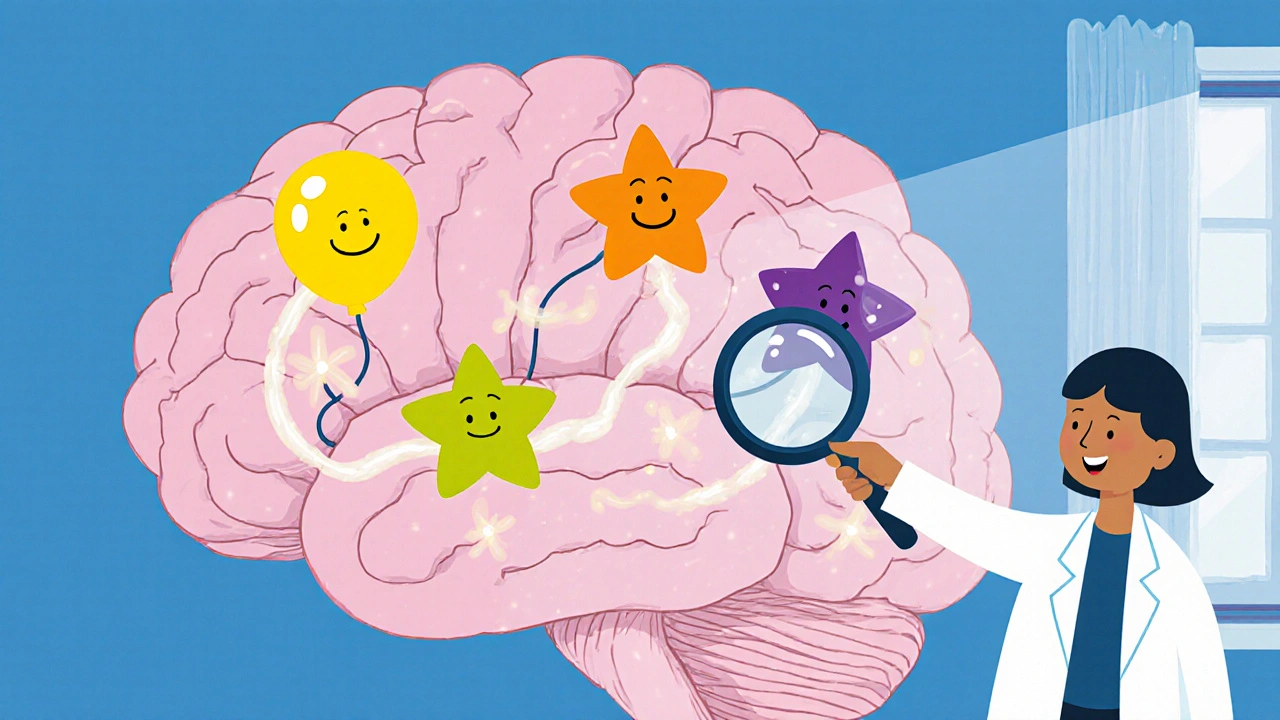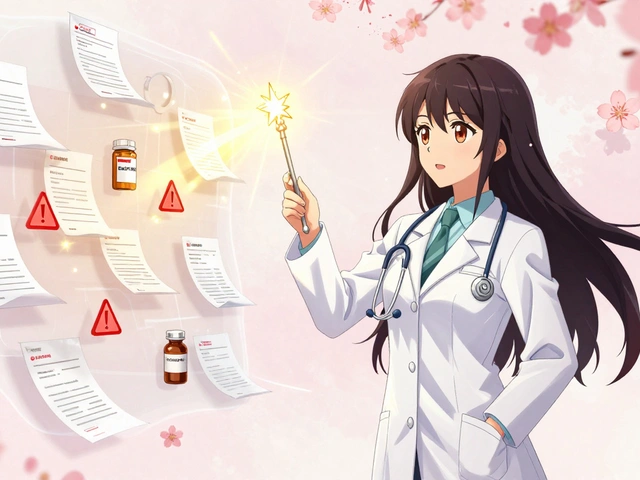Antidepressant Side Effect Tracker
Track Your Symptoms
Symptom Analysis
Low RiskNext Steps
Depression affects more than 280 million people worldwide, and nearly half of those diagnosed will be offered a prescription at some point. Yet most patients wonder: what actually happens inside my brain when I take an antidepressant? This article breaks down the chemistry, the clinical expectations, and the side‑effects you might notice, so you can talk to your doctor with confidence.
When doctors prescribe antidepressant medicationsdrugs that alter brain chemistry to relieve depressive symptoms, they are tapping into a network of neurotransmitters that control mood, motivation, and sleep. Understanding how an antidepressant medication works can help you make informed decisions about dosage, timing, and what to watch for.
Key Neurotransmitters Targeted by Antidepressants
The brain communicates through chemical messengers called neurotransmitters. Three of them are most relevant to depression:
- Serotonina mood‑stabilizing neurotransmitter that regulates anxiety, appetite, and sleep
- Norepinephrinehelps maintain alertness and energy, influencing stress response
- Dopaminedrives motivation, pleasure and reward processing
Most antidepressants increase the availability of one or more of these chemicals, either by blocking reuptake (so the brain retains them longer) or by slowing down their breakdown.
Major Classes of Antidepressants and How They Differ
Below is a quick snapshot of the four main families you’ll hear about in a clinic.
| Class | Primary Mechanism | Typical Onset | Common Side Effects |
|---|---|---|---|
| Selective serotonin reuptake inhibitors (SSRIs)block serotonin reabsorption, raising its level in synaptic gaps | Serotonin ↑ | 2-4 weeks | Nausea, sexual dysfunction, insomnia |
| Serotonin‑norepinephrine reuptake inhibitors (SNRIs)inhibit reuptake of both serotonin and norepinephrine | Serotonin & Norepinephrine ↑ | 2-4 weeks | Dry mouth, elevated blood pressure, dizziness |
| Tricyclic antidepressants (TCAs)block reuptake of norepinephrine and serotonin; also affect histamine and acetylcholine | Norepinephrine & Serotonin ↑ | 1-3 weeks | Weight gain, constipation, cardiac arrhythmias |
| Monoamine oxidase inhibitors (MAOIs)inhibit the enzyme that breaks down serotonin, norepinephrine, and dopamine | All three ↑ | 3-6 weeks | Hypertensive crisis with tyramine foods, dizziness, insomnia |
Pharmacokinetics: How the Body Handles Antidepressants
After you swallow a pill, it travels through the gastrointestinal tract, is absorbed into the bloodstream, and eventually reaches the brain. The liver’s Cytochrome P450 enzymesa family of proteins that metabolize many drugs, including most antidepressants (especially CYP2D6 and CYP3A4) play a big role. Genetic variations can make you a “fast” or “slow” metabolizer, which explains why some people need higher doses while others experience side effects at the lowest dose.
Key pharmacokinetic concepts to know:
- Half‑life: the time it takes for the drug’s plasma concentration to drop by half. Short‑acting drugs (e.g., fluoxetine’s active metabolite) may need daily dosing, while long‑acting agents (e.g., fluoxetine itself) can be taken less frequently.
- Therapeutic lag: even after steady blood levels, noticeable mood improvement usually takes 2-4 weeks because downstream neuronal adaptations-like receptor sensitivity changes-need time.
- Drug‑drug interactions: combining an SSRI with certain antihistamines or antifungals can raise SSRI levels, increasing the risk of serotonin syndrome.

Typical and Serious Side Effects
Side effects are the most common reason patients stop a medication early. Distinguish between “typical” (often transient) and “serious” (require immediate medical attention).
Typical, often temporary, effects
- Gastrointestinal upset - nausea, diarrhea, or loss of appetite. Usually fades within the first two weeks.
- Sexual dysfunction - reduced libido, delayed ejaculation, or anorgasmia. A major reason for non‑adherence; dose adjustment or switching class can help.
- Insomnia or somnolence - some agents are more activating (e.g., fluoxetine), whereas others are sedating (e.g., mirtazapine).
- Weight changes - TCAs and some MAOIs can cause weight gain; SSRIs are more weight neutral.
Serious, less common, red‑flag symptoms
- Serotonin syndromea potentially life‑threatening condition from excess serotonin activity: agitation, high fever, rapid heart rate, dilated pupils, muscle rigidity. Stop the drug and seek emergency care.
- Increased suicidal thoughts - especially in patients under 25 during the first few weeks. Close monitoring by a clinician is essential.
- Hypertensive crisis with MAOIs - eating aged cheese, cured meats, or red wine can trigger dangerous blood pressure spikes.
- Withdrawal or discontinuation syndrome - dizziness, electric‑shock sensations (“brain zaps”), irritability when stopping abruptly. Taper slowly under medical guidance.
Practical Tips for Managing Side Effects
Here’s a quick checklist you can bring to your next appointment:
- Track symptoms daily in a simple table (mood rating, sleep hours, side‑effects severity).
- Report any new or worsening symptoms within the first two weeks.
- Ask about dose timing - taking an SSRI with breakfast can reduce stomach upset.
- Discuss possible switches if sexual dysfunction or weight gain becomes problematic.
- Never stop a drug abruptly; ask for a taper schedule if you decide to discontinue.
Remember, the goal isn’t just symptom relief-it’s restoring functional daily life. Communicating openly with your prescriber speeds up that process.

When Medication Isn’t Enough
Antidepressants work best when paired with psychotherapy, lifestyle changes, and social support. Cognitive‑behavioral therapy (CBT) often accelerates response, while regular exercise, adequate sleep, and a balanced diet can amplify the drug’s benefits.
In resistant cases (no improvement after two adequate trials), clinicians may consider augmentation strategies such as adding atypical antipsychotics, lithium, or thyroid hormone. These decisions are highly individualized and require close monitoring.
Future Directions: New Molecules on the Horizon
Research is moving beyond the classic monoamine model. Novel agents like ketamine (an NMDA receptor antagonist) and psilocybin (a serotonergic hallucinogen) have shown rapid antidepressant effects, sometimes within hours. While still under investigation, they hint at a future where “fast‑acting” treatments could replace the weeks‑long therapeutic lag of traditional drugs.
Gene‑therapy and personalized medicine-using your CYP450 genotype to pick the right dose-are also gaining traction. As science evolves, the core principle stays the same: match the right mechanism to the patient’s biology and preferences.
Frequently Asked Questions
How long does it take for an antidepressant to start working?
Most people notice a subtle lift in mood after 2-4 weeks, but full therapeutic effects can take up to 8 weeks. Early side effects often appear within the first few days.
Can I take an SSRI with over‑the‑counter pain relievers?
Generally, NSAIDs (ibuprofen, naproxen) are safe, but acetaminophen combined with certain antidepressants can affect liver enzymes. Always check with your doctor or pharmacist.
Why do some people feel more anxious when starting an antidepressant?
Activation of serotonin pathways can initially increase anxiety or agitation. This usually subsides after the first week; dose adjustment may be needed.
Is it safe to combine an antidepressant with psychotherapy?
Yes, the combination is considered best practice. Medication stabilizes neurochemistry while therapy provides coping skills and behavioral change.
What should I do if I miss a dose?
Take the missed pill as soon as you remember, unless it’s almost time for the next dose. Then skip the missed one and continue with your regular schedule. Never double‑dose.





Darlene Young
The modern antidepressant landscape is a mosaic of chemistry and patient experience, and understanding each tile can empower you when you sit down with your prescriber. SSRIs, for instance, gently coax serotonin to linger longer between neurons, often easing low mood within weeks. SNRIs add norepinephrine to the mix, offering a boost of alertness that can counteract that heavy‑brain fog. Tricyclics, though older, still shine for some because they also touch histamine and acetylcholine pathways, albeit with a richer side‑effect profile. MAOIs demand dietary vigilance but can be a lifesaver when other classes falter. Keep an eye on the half‑life of your drug – it dictates dosing frequency and withdrawal risk. Genetic variations in CYP450 enzymes mean two people on the same dose can have wildly different blood levels. Monitoring side effects early, especially sexual dysfunction or insomnia, can prevent premature discontinuation. Remember that medication is most effective when paired with therapy, exercise, and social support. Finally, never abruptly stop a pill; tapering under medical guidance avoids the dreaded “brain zaps.”
Steve Kazandjian
SSRIs can take a few weeks before you notice any lift in mood.
Roger Münger
When evaluating the pharmacodynamics of antidepressant agents, it is essential to delineate the precise molecular targets that modulate synaptic neurotransmitter concentrations. Selective serotonin reuptake inhibitors (SSRIs) function by binding to the serotonin transporter protein (SERT), thereby obstructing the reabsorption of serotonin into the presynaptic neuron and increasing extracellular serotonin availability. Serotonin–norepinephrine reuptake inhibitors (SNRIs) extend this mechanism by concurrently inhibiting the norepinephrine transporter (NET), which augments both serotonergic and noradrenergic signaling pathways. Tricyclic antidepressants (TCAs) possess a broader receptor interaction profile; they antagonize histamine H1 receptors, muscarinic acetylcholine receptors, and α1-adrenergic receptors, in addition to blocking SERT and NET, which accounts for their diverse side‑effect spectrum. Monoamine oxidase inhibitors (MAOIs) impede the activity of the mitochondrial enzyme monoamine oxidase, preventing the catabolism of serotonin, norepinephrine, and dopamine, thus elevating the levels of all three monoamines. The therapeutic lag observed in clinical practice, typically spanning two to four weeks, reflects the time required for downstream neuroplastic adaptations, such as changes in receptor density and intracellular signaling cascades, rather than mere pharmacokinetic steady state. Cytochrome P450 isoforms, particularly CYP2D6 and CYP3A4, metabolize the majority of these compounds, and polymorphisms in these enzymes can render patients ultra‑rapid or poor metabolizers, influencing both efficacy and toxicity. Half‑life variability, exemplified by fluoxetine’s long half‑life of several days versus the short half‑life of paroxetine, informs dosing schedules and withdrawal considerations. Drug–drug interactions, such as the concomitant use of selective serotonin reuptake inhibitors with serotonergic agents, can precipitate serotonin syndrome, characterized by autonomic instability and neuromuscular hyperactivity. Moreover, the risk of hypertensive crisis with MAOIs necessitates strict dietary restrictions to avoid tyramine‑rich foods. Clinicians should also be vigilant for emerging evidence on rapid‑acting agents, including NMDA receptor antagonists like ketamine, which demonstrate antidepressant effects within hours, challenging the traditional temporal framework of treatment response. Genetic testing for CYP450 variants is increasingly accessible and may guide personalized dosing strategies, reducing trial‑and‑error prescribing. Ultimately, a comprehensive understanding of the mechanistic nuances, metabolic pathways, and patient‑specific factors is indispensable for optimizing therapeutic outcomes in depressive disorders.
Gerald Bangero
Wow, that deep dive really helps put the puzzle together; it’s like each drug is a different key for a lock in the brain. I definitely hadn’t considered how the enzyme genetics shape our response – it’s wild how a tiny gene can flip the whole experience. The bit about neuroplastic changes makes sense; you can’t expect instant fireworks, it’s more like a garden slowly blooming. And yeah, the diet warning with MAOIs – I’ve heard horror stories about cheese causing a crisis, kinda funny but also scary. Thanks for breaking it down in a way that even a non‑science brain can grasp. It gives me confidence to ask my doc about genetic testing next time.
John Nix
It is prudent to approach antidepressant therapy with a rigorous assessment of both therapeutic benefits and potential adverse effects. Prior to initiation, a thorough evaluation of the patient’s medical history, concomitant medications, and hepatic function should be conducted. Particular attention must be paid to agents metabolised by CYP450 isoenzymes, as interactions may precipitate toxicity. Informed consent ought to encompass discussion of the anticipated latency period for clinical improvement, typically spanning two to four weeks, as well as the spectrum of common side‑effects such as gastrointestinal disturbance and sexual dysfunction. Patients should be instructed to report emergent symptoms of serotonin syndrome or hypertensive episodes without delay. Finally, a structured tapering protocol is recommended when discontinuation is contemplated, to mitigate withdrawal phenomena.
xie teresa
I hear you, and it can feel overwhelming at first. It helps to keep a simple daily log – note mood, sleep, any side‑effects – and bring that to your appointments. That way your clinician can see patterns and adjust dosage or switch meds if needed. Also, remember you’re not alone; many people navigate these waters and find relief with the right combination. Your openness about concerns is already a strong step toward better mental health.
Kayla Rayburn
One practical tip I’ve found works is timing your dose with a regular routine, like taking your SSRI with breakfast. If you notice stomach upset, having it with food can smooth it out. Also, tracking any changes in libido or weight can signal when a switch might be beneficial. Don’t forget to discuss any persistent insomnia – sometimes a low‑dose sedating antidepressant at night can make a big difference.
Dina Mohamed
Great suggestions, especially the breakfast tip!; I’d add that keeping a mood diary can really highlight subtle improvements; even a tiny shift in energy or optimism is worth noting; and if side‑effects feel intolerable, a brief pause to discuss dosage tweaks with your prescriber can be a game‑changer; consistency really matters, but flexibility does too, so stay in touch with your doctor regularly.
Kitty Lorentz
I had brain zaps when i stopped cold turkey they were scary but i tapered slowly and they went away
Jenny Newell
This article is solid, though the jargon could be trimmed for lay readers; overall a comprehensive review.
Kevin Zac
Appreciate the thoroughness; when discussing termination strategies with patients, I always emphasize a gradual taper, usually reducing the dose by about 10‑20% every one to two weeks, to minimize withdrawal phenomena. Also, reviewing the patient’s full medication list for potential serotonergic load can preempt serotonin syndrome.
Bianca Fernández Rodríguez
Honestly, the whole serotonin‑centric model feels outdated; newer research points to inflammation and neurogenesis as key players, so focusing solely on reuptake inhibition might be missing the bigger picture.
Patrick Culliton
While inflammation is an interesting angle, the clinical efficacy of SSRIs remains robust across thousands of trials; dismissing them outright ignores the real‑world benefits many patients report.
Andrea Smith
It is commendable to explore emerging mechanisms, yet the established pharmacotherapies continue to provide substantial relief when applied judiciously; integrating lifestyle modifications can further augment treatment outcomes.
Claire Mahony
While I respect the enthusiasm for novel approaches, one must remain cautious; many promising agents falter in rigorous trials, and premature adoption can expose patients to unforeseen risks.
Andrea Jacobsen
Collaboration between clinician and patient is key – sharing decision‑making about medication choice, monitoring, and adjustments leads to better adherence and outcomes.
Andrew Irwin
Agreed, a gentle, patient‑centered approach usually works best; small steps and open dialogue go a long way.